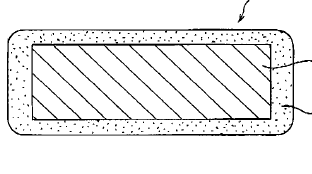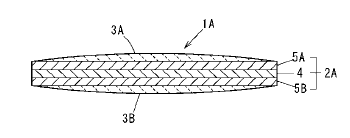IP high court considered the problem to be solved in argument of substantial identity.
IP Court Case Summary:H24 (gyoke) 10433
1. Claimed Invention and Cited Invention
The title of the invention at issue is “Rectangular Conductor for Solar Cell, its Manufacturing Method and Lead Wire for Solar Cell”. Claimed invention is “The rectangular conductor for the solar cell having the volume resistivity of 50 μΩ mm or less and 0.2% strength value of 90 MPa or less (excluding less than 49 MPa) in a peel test”.
20
1
13

[Claimed Invention]
(note) 20: Lead for Solar Batteries, 1: Conducting Wire, 13: Solder Film
Cited invention is “a core material for the solar cell having the volume resistivity of 2.3 μΩ cm or less and the strength value of 19.6 – 49 MPa in a peel test”.

[Cited Invention]
(note) 1A: Electrode Wire Rod, 2A: Core, 3A/3B: Molten Solder Film, 4: Middle Layer,
5A/5B: Copper Layer
Appeal Board decided the identical and different points between those inventions as following;
<Identical Points>
“The rectangular conductor for the solar cell having the volume resistivity of 50 μΩ mm or less and 0.2% strength value of 90 MPa or less in a peel test”
<Different Points>
Claimed invention excluded “0.2% strength value of 49 MPa or less in a peel test”.
2. Decision by Appeal Board
The range of the resistivity should be a design matter which should be determined depending on structure of constitution and thickness of the semiconductor substrate. The strength value of 49 MPa or less in a peel test was identified according to the design matter. Then, “the strength value of 49 MPa or less in a peel test” is the mere difference only within the design matter.
3. Decision by IP High Court
Even an overlap does not exist between the numerical ranges concerning the resistivity of those two inventions. Therefore, the numerical limitation of claimed invention is totally different from that of cited invention. Moreover, there is not enough evidence that the numerical range of the claimed invention is well-known art or commonly used art.
Both inventions are common at the point of the reduction of a thermal contraction after the solder connection by making a rectangular conductor deform plastically. However, the claimed invention initially considered decreasing the curve of the cell, and the numerical range concerning the resistivity was determined. On the other hand, the prior invention initially considered preventing a crack occurring to semiconductor substrate, and the numerical range concerning the resistivity was determined. The problem to be solved in both inventions was not the same.
Thus, finally the range of the resistivity cannot be deemed to be the design matter.
<Comments>
In this decision by IP high court, the difference of the problems to be solved was considered in the discussion of the “very minor difference”. In the argument of “very minor difference”, it should be effective to explain the difference of the problem to be solved (as well as the difference of numerical limitations) from now.
http://www.ip.courts.go.jp/hanrei/pdf/20130919164414.pdf